Drum Library User Guides
Aaron Sterling - User Guide
Updated 16 hours ago
Overview
Aaron Sterling’s playing has defined the sound of modern records for over two decades, from John Mayer and Taylor Swift to Harry Styles and Leonard Cohen. Revered for his understated feel and ability to serve the song above all else, Sterling is one of the most recorded drummers of his generation.
Kit Specifications
Kicks
20 x 14" 70's Slingerland Kick
22 x 14" 80's Ludwig Standard Kick
26 x 10" 80's Ludwig Marching Kick
Snares
13 x 5" 60's Trixon Wood Snare
13 x 6" 50's WFL Mahogany Snare
13 x 5.5" 60's Ludwig Wooden Hoop Snare
Toms
12 x 9" 70's Slingerland Rack Tom
14 x 14" 70's Slingerland Floor Tom
12 x 9" 70's Slingerland Rack Tom (Muted)
14 x 14" 70's Slingerland Floor Tom (Muted)
Hi-Hat
15" Istanbul Agop XIST Dark Hi-Hats
Crashes
18" Istanbul Agop Xist Dark Crash
17" Istanbul Agop Xist Dark Crash
Ride
21" Istanbul Agop XIST Ride
Snapshots
Below is a list of all the available snapshot presets in the Mario Duplantier library. For a general overview of snapshots, visit the Snapshots Overview.
Default Kit
Default Kit (Unmixed)
Middle Panning
Middle Panning (Unmixed)
WFL and Muted Toms
Wood Snare
Boomy Kick
Marching Kick
Drum Library User Interface
Interface Layout & Basic Usage
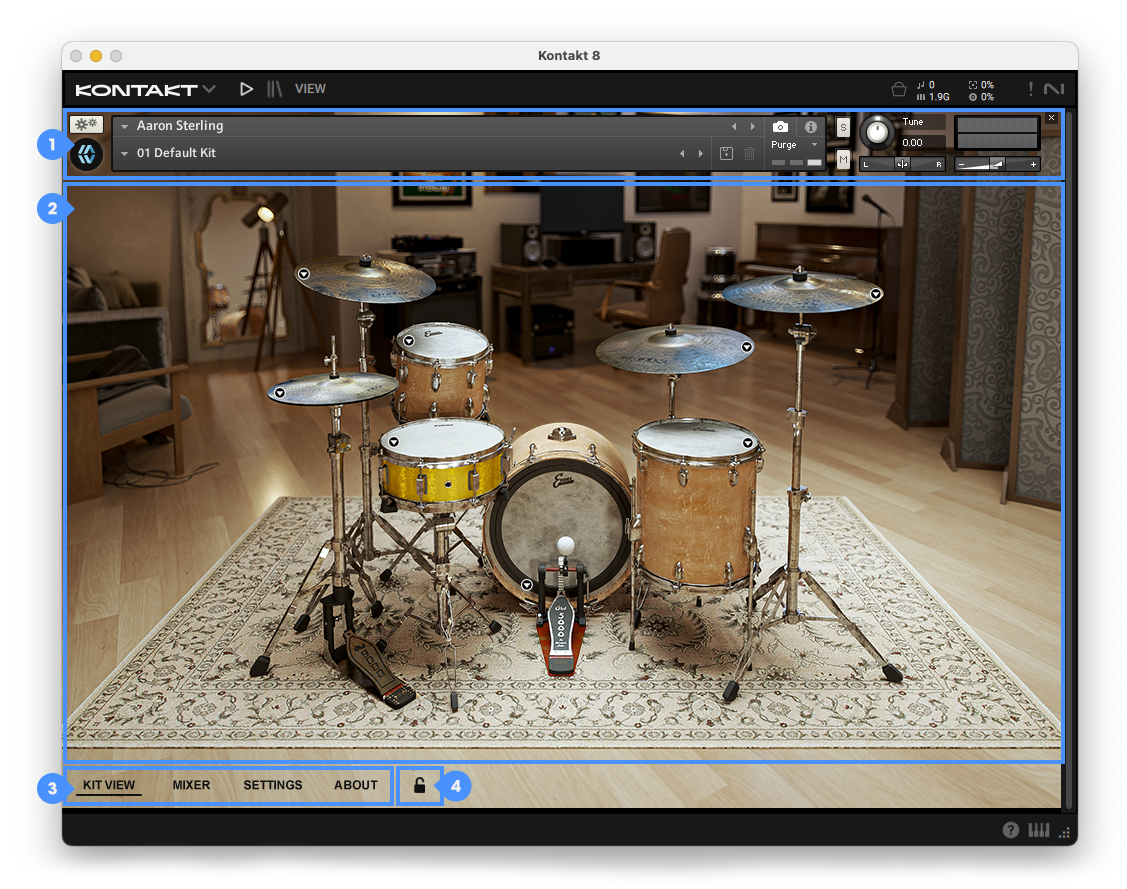
Each MixWave drum library features its own unique visual design. The overall layout and controls remain consistent across all libraries including the following interface elements:
Kontakt Instrument Header
Library Interface
Navigation Bar
Preset Lock
For a full explanation of each section, and general overview of Graphic User Interface (GUI) basics, visit the Drum Library User Interface article.
Kit View

The Kit View provides a visual layout of the drums and cymbals included in the library. From this view, you can audition kit pieces by clicking on them, load or unload individual elements, and swap between available kit piece variations using the following controls:
Drum Menus
Trigger on Click
For more information on the Kit View section controls, view the Kit View article.
Mixer
Mixer Layout
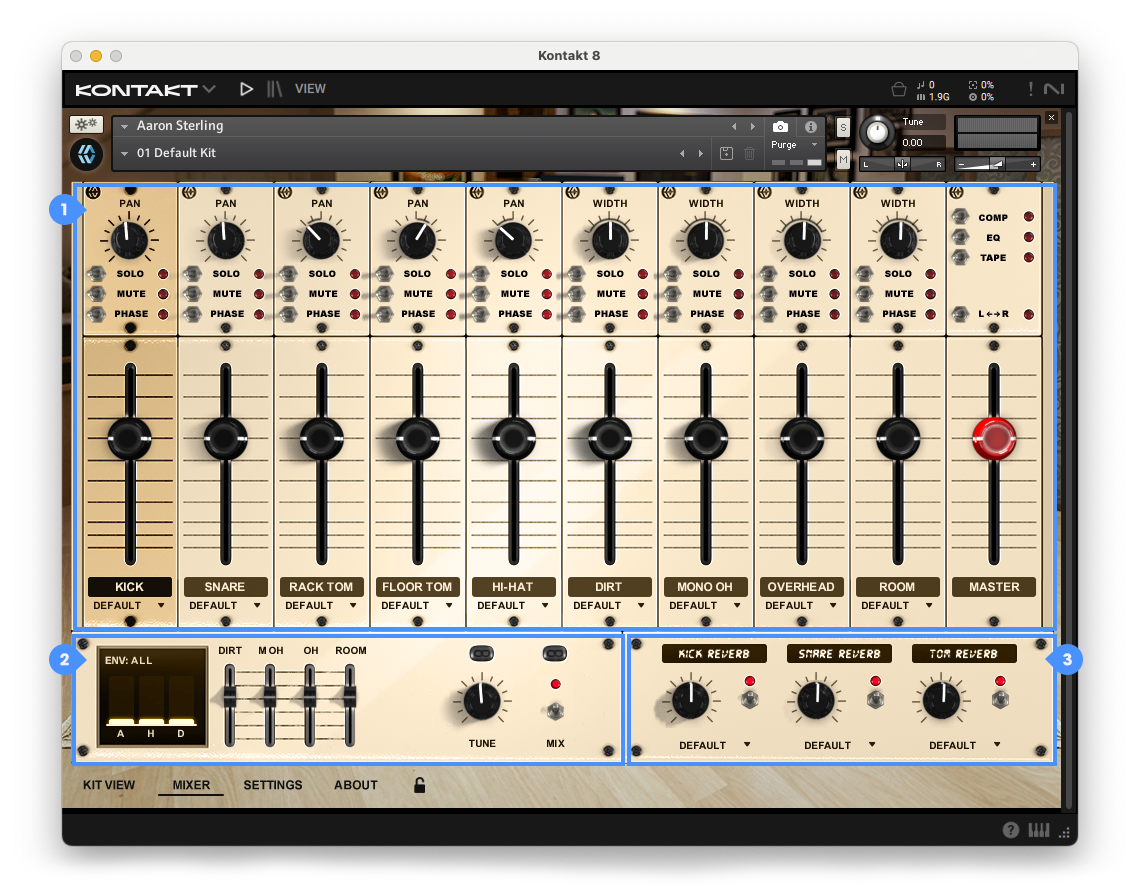
The Mixer section provides control over individual mic channels and multiple output routing. This includes the following sections:
Mixer Channels for volume and panning adjustments.
Mix Panel and Master Panel for sub-mixer controls and master effects.
Reverb Panel for sampled reverbs.
For more information on the Mixer Section, view the General Mixer Interface Overview .
Mixer Channels
The Mixer section in this library includes a set of core controls for each drum and cymbal channel. The image below shows an overview of the Mixer interface with each numbered control labeled for reference:
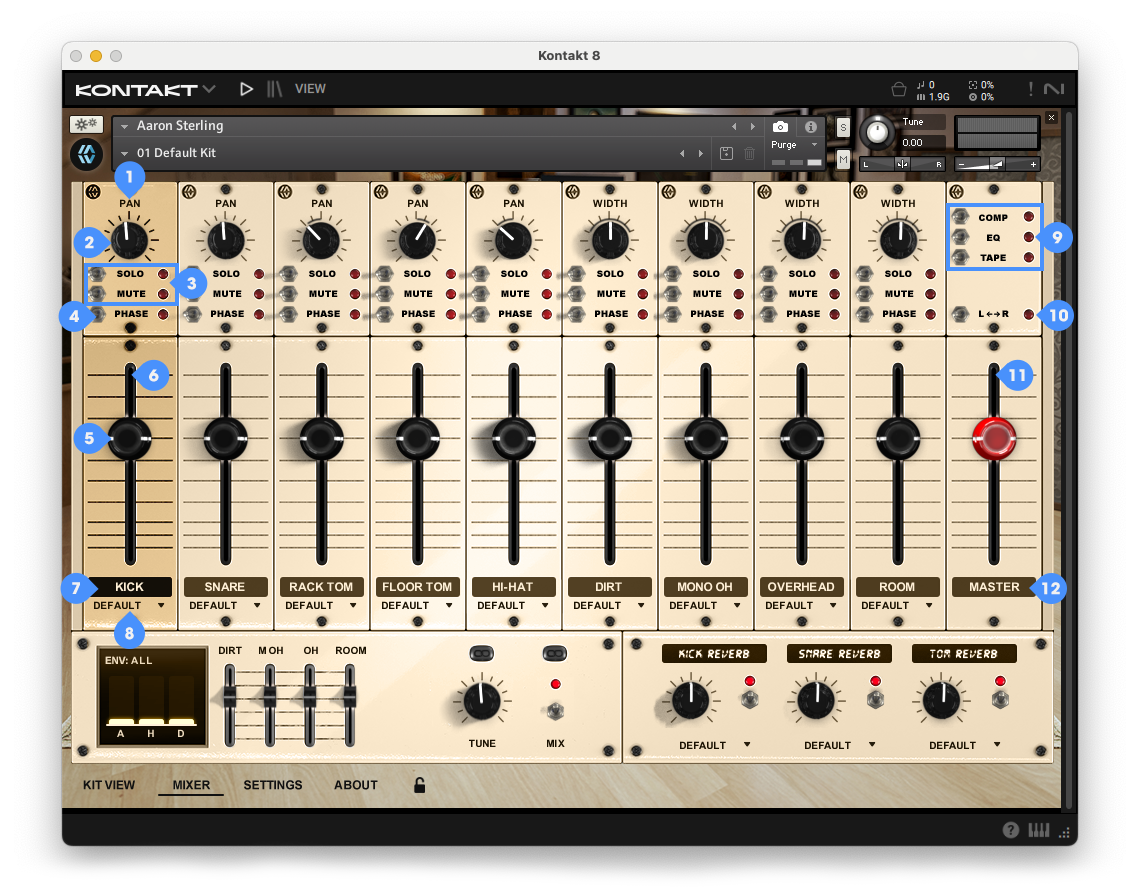
Pan and Width Labels
Pan and Width Knobs
Solo and Mute Buttons
Phase Buttons
Volume Sliders
Level Meter
Channel Labels
Output Menus
Master Channel Inserts (Comp, EQ & Tape)
Master Left / Right Swap
Master Level Meter
Master Channel Label
To learn more about these features and how each control functions, view the Mixer Channels article.
Main & Sub Mixer Channels
Each main mixer channel controls the overall level of a specific drum, cymbal, or ambient microphone. Under each of these channels, sub channels provide independent control over the bleed captured by different microphone types (e.g., Overhead, Room). This gives you precise control over the mix, down to individual mic perspectives.
Kick
Controls the main level of the Kick In microphone.
Dirt: Kick bleed in the dirt mic.
Mono Overhead (M OH): Kick bleed in the mono overhead mic.
Overhead (OH): Kick bleed in the overhead mics.
Room: Kick bleed in the room mics.
Snare
Controls the main level of the Snare Top microphone.
Dirt: Snare bleed in the dirt mic.
Mono Overhead (M OH): Snare bleed in the mono overhead mic.
Overhead (OH): Snare bleed in the overhead mics.
Room: Snare bleed in the room mics.
Rack & Floor Tom
Includes the Rack Tom and Floor Tom. Each has its own close mic level control.
Dirt: Tom bleed in the dirt mic.
Mono Overhead (M OH): Tom bleed in the mono overhead mic.
Overhead (OH): Tom bleed in the overhead mics.
Room: Tom bleed in the room mics.
Hi-Hat
Controls the main level of the Hi-Hat microphone.
Dirt: Hi-hat bleed in the dirt mic.
Mono Overhead (M OH): Hi-hat bleed in the mono overhead mic.
Overhead (OH): Hi-hat bleed in the overhead mics.
Room: Hi-hat bleed in the room mics.
Dirt, Mono Overhead, Overhead, & Room
Includes the Ride, Crash 1, and Crash 2.
Ride: Volume of the Ride in each ambient mic channel.
Crash 1 (CR 1): Volume of Crash 1 in each ambient mic channel.
Crash 2 (CR 2): Volume of Crash 2 in each ambient mic channel.
Master
Adjusts the final output level of all mic channels and effects within the instrument.
Mix Panel
The Mix Panel, located at the bottom left of the Mixer interface, provides advanced control over shaping each channel’s dynamics, tuning, and the option to toggle between mixed/unmixed samples. The image below highlights each numbered control element:

Envelope Controls
Sub Channel Button
Sub Channel Volume
Tune Link Switch
Tune Knob
Mix Link Switch
Mix Switch
To learn more about how these features function and when to use them, view the Mix Panel Controls article.
Master Panel
The Master Panel, located at the bottom left of the Mixer interface when the Master Channel is selected, offers additional creative control over your drum mix with onboard compression, EQ, and tape saturation. The image below highlights each numbered control element:

Compressor Bypass Switch
Mix Knob
Threshold Knob
Makeup Knob
EQ Bypass Switch
Low Knob
Low Mid Knob
High Mid Knob
High Knob
Tape Bypass Switch
Amount Knob
Tone Knob
To learn more about these features and how they function, view the Master Panel Controls article.
Reverb Panel
The Reverb Panel, located at the bottom right of Mixer interface, offers control of the sampled reverb levels. The image below highlights each control element:
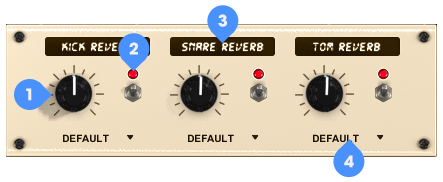
Reverb Volume Knob
Reverb Bypass Switch
Reverb Name
Reverb Multi-Output Menu
To learn more about these features and how they function, view the Reverb Panel Controls article.
Settings
Global Controls

The global controls available in the Settings section are as follows:
Preview Velocity Switch
Preview Velocity
Mapping Preset Menu
For more information on these controls and their functionalities, view the Settings Global Controls article.
MIDI Mapping
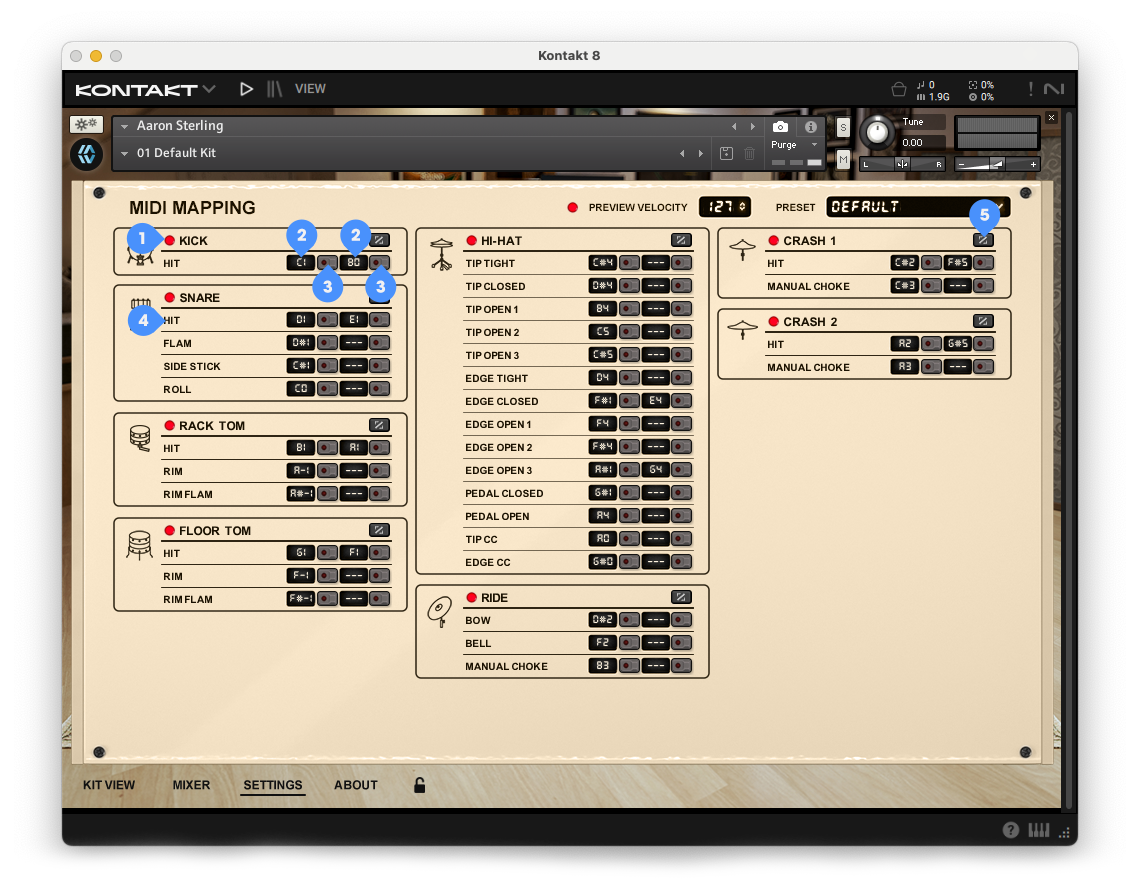
The arrangement of kit pieces in the MIDI Mapping section will vary depending on the library, however the control structure remains the same that includes:
Kit Piece Purge
Primary & Secondary Map Keys
Primary & Secondary MIDI Learn
Articulation Name
Velocity Curve Editor
More detailed information on these controls and their functionalities can be viewed in the MIDI Mapping Section article.
Velocity Curve & Hi-Hat Control
The Velocity Curve and/or MIDI CC pop up is revealed by clicking any Velocity Curve Edit button throughout the main Settings section. Offering more precise control over the incoming dynamics from the source MIDI or MIDI controller per kit piece and extended Hi-Hat CC settings. The image below highlights each control element:
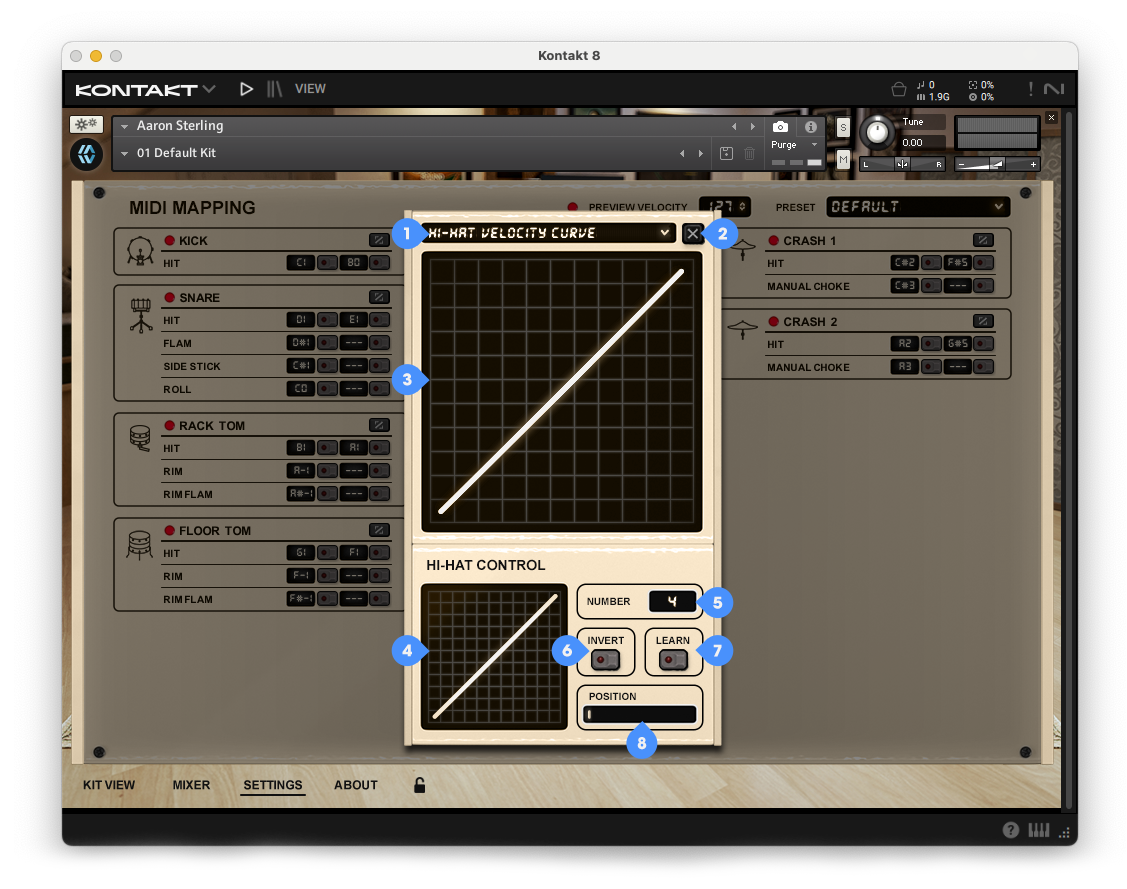
Kit Piece Curve Editor Select
Exit Button
Main Velocity Curve
Hi-Hat Velocity Curve
CC Number
CC Invert Button
CC Learn Button
CC Position
Articulations & MIDI Map Layout
This section includes a complete breakdown of all articulations and their corresponding default MIDI, and native groove pack note assignments. For a more in depth overview of articulations, visit the Drum Library: Articulations Overview.
Kit Piece | Articulation | MIDI Note |
Kick | Hit | C1 / B0 |
Snare | Hit | D1 / E1 |
Flam | D#1 | |
Side Stick | C#1 | |
Roll | C0 | |
Rack Tom | Hit | B1 / A1 |
Rim | A-1 | |
Rim Flam | A#-1 | |
Floor Tom | Hit | G1 / F1 |
Rim | F-1 | |
Rim Flam | F#-1 | |
Hi-Hat | Tip Tight | C#4 |
Tip Closed | D#4 | |
Tip Open 1 | B4 | |
Tip Open 2 | C5 | |
Tip Open 3 | C#5 | |
Edge Tight | D4 | |
Edge Closed | F#1 / E4 | |
Edge Open 1 | F4 | |
Edge Open 2 | F#4 | |
Edge Open 3 | A#1 / G4 | |
Pedal Closed | G#1 | |
Pedal Open | A4 | |
Tip CC | A0 | |
Edge CC | G#0 | |
Ride | Bow | D#2 |
Bell | F2 | |
Manual Choke | B3 | |
Crash 1 | Hit | C#2 / F#5 |
Manual Choke | C#3 | |
Crash 2 | Hit | A2 / G#5 |
Manual Choke | A3 |
About
Clicking the About button in the bottom navigation of every library interface will show the About Section. This will display the current library version number, library framework version that is installed along with the build date information. It is recommended to double check this page after installing any available update to confirm it was installed correctly.

Disclaimer
Aaron Sterling names/logos/designs are all trademarks belonging to their respective owners and
are used with expressed permission from their respective owners.
